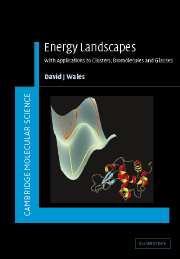Book contents
- Frontmatter
- Contents
- Preface
- 1 Introduction
- 2 The Born–Oppenheimer approximation and normal modes
- 3 Symmetry considerations
- 4 Features of the landscape
- 5 Describing the landscape
- 6 Exploring the landscape
- 7 Properties of the landscape
- 8 Clusters
- 9 Biomolecules
- 10 Glasses and supercooled liquids
- Appendix A Sylvester's law of inertia
- Appendix B Derivation of Ω(E, P, L)
- Index
8 - Clusters
Published online by Cambridge University Press: 05 October 2013
- Frontmatter
- Contents
- Preface
- 1 Introduction
- 2 The Born–Oppenheimer approximation and normal modes
- 3 Symmetry considerations
- 4 Features of the landscape
- 5 Describing the landscape
- 6 Exploring the landscape
- 7 Properties of the landscape
- 8 Clusters
- 9 Biomolecules
- 10 Glasses and supercooled liquids
- Appendix A Sylvester's law of inertia
- Appendix B Derivation of Ω(E, P, L)
- Index
Summary
This chapter provides further examples of potential energy surfaces for clusters, with emphasis upon how the thermodynamic and dynamic properties observed in simulations or experiments are determined by details of the PES. First the phenomenology of thermodynamics in finite systems is discussed, followed by an analysis of stability conditions for the most popular ensembles. Some technicalities involved in cluster simulation are discussed in Section 8.2, and an example is given for the LJ7 cluster. The subsequent sections treat various different systems, including Lennard-Jones, Morse, alkali halide, and water clusters, as well as buckminsterfullerene. Among the issues that are analysed in detail are the evolution of the PES with size for Lennard-Jones clusters, and the effect of the range of the potential for Morse clusters, which may provide insight into a number of different phenomena. Dynamics, including relaxation of the total energy, have been treated using the master equation approach (Section 7.2.2) for several of these systems.
Finite size phase transitions
A first-order phase transition in a bulk system occurs when the appropriate thermodynamic potential (e.g. Helmholtz free energy or entropy for the canonical and microcanonical ensembles) exhibits a double minimum (or maximum) over some range of parameter space, with a finite barrier (or well) between the two extrema. For a solid–liquid transition the control parameter may be either temperature or pressure. For conditions of constant N, P and T the transition occurs where the chemical potentials of the solid and liquid phases are equal.
- Type
- Chapter
- Information
- Energy LandscapesApplications to Clusters, Biomolecules and Glasses, pp. 434 - 529Publisher: Cambridge University PressPrint publication year: 2004

